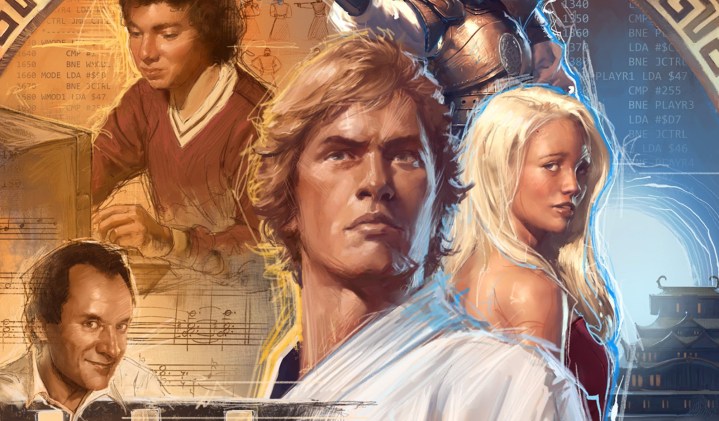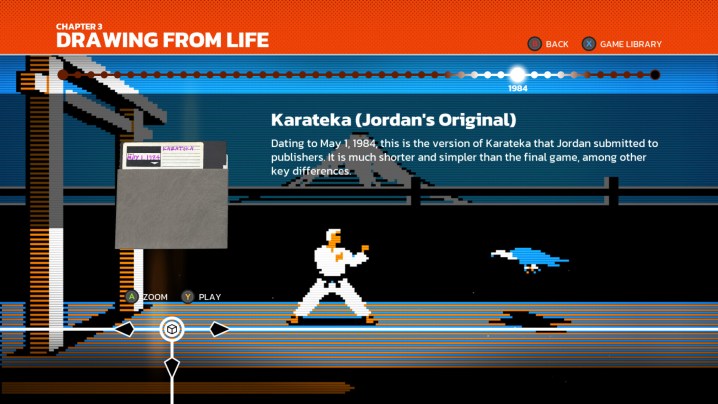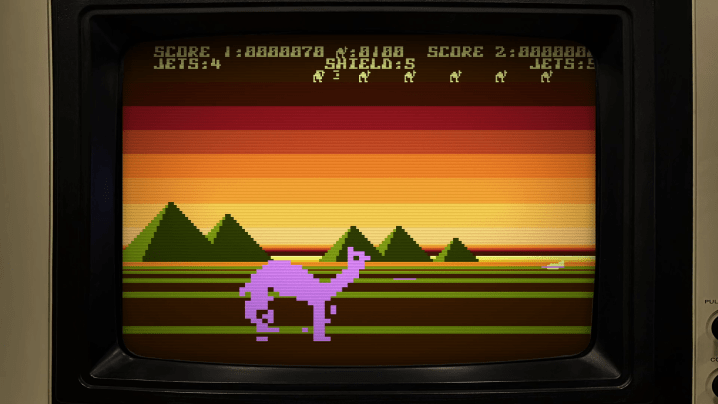

The primary purpose of video game remasters and re-releases is to preserve and modernize a classic experience, but there are a lot of ways to accomplish that. A lot of studios simply port or emulate an old game on modern platforms and call it a day. Any additional perks, like behind-the-scenes featurettes, is tossed in as bonus content. For Chris Kohler, the Editorial Director at Digital Eclipse Editorial, that’s a philosophy his team wants to avoid.
“The core user experience is us wanting to tell the story of video game history, and the video games themselves are a part of that, but they’re not the whole show,” Kohler told Digital Trends during an interview about its 2023 release, The Making of Karateka. “I bristle when I hear ‘bonus materials’ being thrown around. We don’t want it to be bonus materials; we want everything to be the main event.”
Back in the 1990s, Digital Eclipse established itself as one of the industry’s premiere game-remastering studios. Its efforts have evolved over the past year thanks to Atari 50: The Anniversary Collection and The Making of Karateka. These are self-described “interactive documentaries” that feel like museum exhibits for games to come to life. They present not just the classic games themselves but the context in which they launched in the form of interactive timelines. It’s a style of game Digital Eclipse will keep making under its Gold Master Series banner.
The Making of Karateka is a shining example of this new kind of game remaster, as it goes deeper into the story of the person behind an influential classic. Although Jordan Mechner is most famous for creating the Prince of Persia series, Karateka predated that franchise and trailblazing narrative and animation in video games. The Making of Karateka delves into the story of its creation across four chapters. Through a series of playable game builds, viewable development documents, and interviews with developers influenced by Karateka, this remaster goes a step beyond its peers by providing greater context and insight into the subject matter’s creation and influence.
The project answers the who, what, where, and why questions that anyone would want to know about Karateka. In speaking with Chris Kohler about the game, it’s clear why The Making of Karateka made such a splash this year. It’s a love letter to the people who create and are inspired by video games, capturing something that few game remasters before it have: legacy.
The what
Before he was remastering games, Chris Kohler was a journalist. He left a gig at Kotaku in 2020 to join Digital Eclipse, and he tells me that some groundwork for what would become The Making of Karateka and the Gold Master Series had already begun when he arrived. Throughout our conversation, Kohler reiterated how Digital Eclipse believes game remasters should be more than simple port jobs, providing players with the context of the game’s development and legacy.
“Digital Eclipse wanted to branch out into self-publishing because then we could do exactly what we wanted and put out proof-of-concept games that illustrated what this form could be if we had no creative constraints on us,” Kohler says. “When I came in, the concept of the Gold Master Series, The Making of Karateka, and how this would be an interactive documentary that walks you through the making was already there, but it was just the core of this idea.”

Karateka, in particular, was a great subject for this initial self-publishing effort. It’s a 1984 karate action game first released on Apple II computers. It was made by Prince of Persia creator Jordan Mechner. It was highly influential as one of the first games to use rotoscoped animation, include ambitious sound design, and deliver cinematic storytelling. It influenced the developers of games like Wolfenstein 3D and Mortal Kombat, with Digital Eclipse even interviewing some of them for The Making of Karateka. You may not have heard of Karateka, but you’ve almost certainly played games inspired by it. And though Karateka feels dated by modern standards, that made it a prime candidate for a Digital Eclipse project.
“Typically, what’s done is that you have all of this material, and then you build out a museum out of the most interesting bits. How do we take every bit, put that into context, and make it something the player enjoys going through?” Kohler explains.
We became victims of our own success …
According to Kohler, The Making of Karateka faced creative restarts multiple times mid-development. For a long time, archival components like the interviews, documents, and development timelines all felt like “disparate elements” that didn’t come together. The video segments that ended up in the final game were initially just expected to be an hour-or-so documentary that the game would include, separate from the timelines and emulated games. Although Digital Eclipse originally wanted to prove this format via a self-published title, Kohler affirmed it was another work-for-hire project where these ideas would coalesce into something special before being brought back to The Making of Karateka.
The helpful setbacks
The Making of Karateka took a backseat as Digital Eclipse made the Blizzard Arcade Collection, Disney Classic Games: Aladdin and The Lion King, and TMNT: The Cowabunga Collection. After The Cowabunga Collection wrapped development, Kohler says attention shifted back to The Making of Karateka again, but Digital Eclipse put it on hold once more when Atari approached Digital Eclipse with the offer to make a game that’d celebrate its 50th anniversary.
“We became victims of our own success in that we started getting project and project,” Kohler says. “The Making of Karateka, as the self-funded independent work, had to keep getting back-burnered.”

This studio would eventually produce Atari 50: The Anniversary Celebration, the first game released to establish the format that future Gold Master Series titles would follow. Kohler thinks Digital Eclipse won Atari over because it could see the studio’s work on that unreleased, previous version of The Making of Karateka. The work on Atari 50 allowed Digital Eclipse to identify the core things that worked about its timeline-based interactive documentary setup.
Atari 50 and Digital Eclipse’s Gold Master Series are inherently intertwined, as the learnings from the former gave Digital Eclipse the outline that The Making of Karateka could follow. The Making of Karateka launched on August 29, and although it flew a bit under the radar during a month that contained the launch of Baldur’s Gate 3 and Armored Core VI: Fires of Rubicon, it garnered a lot of attention from fans of historical game preservation. I was one of those people, and I put it on my best games of August 2023 list.
The why
The Making of Karateka thoroughly documents the making of and legacy of both Deathbounce, one of Mechner’s unreleased games, but it also doubles as a coming-of-age story for Jordan Mechner, as he must take criticism and feedback on Deathbounce and then improve Karateka throughout its iterative development process. It’s a personal experience turned playable, teaching the importance of criticism and taking feedback in an experiential way. On top of that, The Making of Karateka features remastered versions of Deathbounce and Karateka made by Digital Eclipse itself.
Kohler tells me that Karateka’s remaster was a personal project for Digital Eclipse’s Mike Mika, who previously attempted but never finished an Amiga port for Karateka in the 1980s. Meanwhile, the “finished” version of Deathbounce came about because engineers Dave Rees and Jeremy Williams needed a way to get familiar with the Eclipse engine that The Making of Karateka runs on. According to Kohler, Digital Eclipse initially kept these aspects of the project a secret from Jordan Mechner because Digital Eclipse knew how important getting new versions of his games right was to him. They were both approved after Mechner saw them, thankfully.
Those remasters play a key part in demonstrating why The Making of Karateka feels so special. It’s not just a comprehensive game collection but one that packs in the context and legacy of those titles. Digital Eclipse understood those aspects so well that it could create the “best” versions of these classics, ones that will probably be more approachable to modern audiences that want something substantial to play following their historical curiosity.

That’s a monumental achievement in preserving what makes a classic game like this special. Preservation is still a crisis that the game industry struggles to deal with; this year alone, many 3DS and Wii U games were lost, and they’ll likely never get the treatment Karateka has. Although pure, unadulterated ports are a welcome solution to that crisis, The Making of Karateka is a different type of approachable, playable preservation.
Digital Eclipse did unearth some unpreserved content during the development process, like cassette tapes, including some of Jordan’s earliest work from when he was 13. Kohler says he and Mechner’s family found tucked away in a closet in his father’s apartment and subsequently donated to the Video Game History Foundation. “We’re constantly thinking about not just how do we use this for ourselves, but how do we make sure this is preserved and gets into an institution if it isn’t there already,” Kohler tells us.
That’s one of the things that often doesn’t get preserved: the experience of the people who play the game.
As much as The Making of Karateka is a great remaster that tells a compelling story, it’s also a triumph of game preservation that captures everything that came before. When explaining the process of getting people like Mortal Kombat’s John Tobias or Doom’s Tom Hall to speak about Karateka, Kohler exposed exactly why The Making of Karateka feels like so much more than your standard remaster.
“You have people who bought it on the shelf in 1984 and 1985 and can speak to what it was like to play it in that moment, which is so important,” Kohler says. “To play it today, you can never get the experience that somebody like John Tobias had in 1984. Many of my questions were, ‘How did it influence Mortal Kombat?’ That’s easy, but asking if you remember buying it, why did you buy it, what was it like to boot it up, what was it like to play for the first time, what was it like to beat it for the first time, that’s game preservation too.”
“That’s one of the things that often doesn’t get preserved: the experience of the people who play the game. A game is a two-way street. It’s a thing that’s designed, but it’s a thing that’s experienced, and you have to preserve that as well.”
The future
The Making of Karateka is only the first in what Digital Eclipse hopes is a new line of Gold Master Series games. The second one, Llamasoft: The Jeff Minter Story, was announced at Day of the Devs this month. Speaking to Kohler about this new game ahead of its reveal, he says it’ll be closer to Atari 50 than The Making of Karateka in scope, focusing less on the iteration of individual games and more on the Minter’s expansive career. It will be more personal than Atari 50, though, as the goal with Llamasoft: The Jeff Minter Story is again to tell the story of a subversive and ambitious developer who was influential early on in a more rigid game industry.

Because Atari 50, The Making of Karateka, and Llamasoft: The Jeff Minter Story are all so different from each other in subject matter — and developed somewhat intermittently with each other — Kohler is eager to take a step back and assess what works best for each game as Digital Eclipse charts the path forward for the Gold Master Series now that it’s a subsidiary of Atari.
“We can see what happened when the game was about one company, what happened when it was about one game, and what happens when it’s about one designer,” he says. “We can learn from all three of those things and then try to figure out, for future entries in the Gold Master Series, what makes the most sense to pursue as far as what kind of story that we want to tell. It’s still very early days. We need more data, more insight, into how all three of these are received so we can try to triangulate about what the next things are going to be.”
Kohler wasn’t willing to say anything about what subject matter may come next other than that there are “some things that are being discussed.” No matter what it ends up being, The Making of Karateka and Atari 50 — which is now receiving post-launch support that adds in new games — have laid excellent groundwork for the Gold Master Series to follow. Based on a demo we played at this year’s Day of the Devs live event, Llamasoft: The Jeff Minter Story will follow in their stead.
The biggest strength of The Making of Karateka and other Gold Master Series adjacent titles is that they thoroughly answer those who, what, and why questions that Digital Eclipse recognized are still absent in many remasters. People make video games, and in a year where developers were bombarded by layoffs and disrespected by the industry’s biggest award show, playing something like The Making of Karateka is a reminder of who makes games, who plays games, and why we do those things that I think we can all use after such a hectic 2023.



